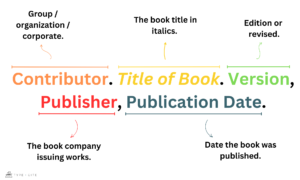Cite a Book with a Group Author in MLA
- Hannah Berry (Ph.D.)
- Published on 05/24/2024
When dealing with books authored by a group rather than an individual, the MLA style has specific guidelines to ensure proper citation. A corporate author may be a commission, a committee, a government agency, or a group that does not list individual members on the title page. This article outlines the steps for citing such works, focusing on the required elements and structure for both the Works Cited entry and in-text citations.
CITATION ELEMENTS OF A BOOK WITH A GROUP AUTHOR
When citing a book with a group author in MLA, the group’s name appears in the author position of the citation. Here are the detailed steps and the structure required:
- Corporate Author(s): When citing a book with a corporate author, use the exact name of the group as presented on the title page of the book. This ensures accuracy and consistency in your citation.
- Title: The title of the book should be italicized to distinguish it from other parts of the citation. This helps readers easily identify the main title of the work being referenced.
- Editions or Versions: If the book is a particular edition or version, include this information after the title. Different editions may have significant changes, so specifying the version is crucial for accurate referencing. Common versions include “2nd ed.” for the second edition or “rev. ed.” for a revised edition. If the book indicates a specific type of edition, ensure that you reflect this in your citation.
- Name of the Publisher: The publisher’s name should be listed next. This identifies the entity responsible for producing the book. It is usually found on the title page or the copyright page of the book.
- Year of Publication: Include the year the book was published. This information is typically found on the title page or the copyright page. The publication date helps readers locate the exact version of the book you are referencing.
- Including a DOI: If the book has a DOI (Digital Object Identifier), include it at the end of the citation. A DOI provides a permanent link to the electronic version of the book. Replace the period after the publication date with a comma before adding the DOI.
EXAMPLE CITATION FOR A BOOK WITH A GROUP AUTHOR
| Citation |
United Nations Intergovernmental Panel. Global Warming of 1.5°C: Impacts and Strategies. 3rd ed., Climate Action Press, 2024, doi:10.1016/ipcc.2024.015.
|
| Structure |
Corporate Author. Title of Book. Version, Publisher, Publication Date, DOI.
|
In this example, “United Nations Intergovernmental Panel” is the group author, “Global Warming of 1.5°C: Impacts and Strategies” is the title of the book, “Climate Action Press” is the publisher, and “2024” is the publication date. The DOI “doi:10.1016/ipcc.2024.015” is included after the publication date, replacing the period.
EXAMPLE IN-TEXT CITATION FOR A BOOK WITH A GROUP AUTHOR
In-text citations for a book with a group author MLA style provides two ways to include in-text citations: narrative and parenthetical.
In narrative citations, the group author’s name is incorporated into the text, followed by the page number in parentheses.
| Example | National Institute of Health (25) |
| Structure | Author (Pg. No(s) |
In parenthetical citations, both the corporate author’s name and the page number appear in parentheses at the end of the sentence.
| Example | (National Institute of Health 25) |
| Structure | (Author Pg. No(s) |
 |
Group Author: When citing a corporate author whose name begins with “The,” such as “The National Institute of Health,” omit “The” in your citation. Instead, cite the organization as “National Institute of Health.” Ensure Accurate Formatting for Multiple Works by the Same Group Author: When citing multiple books by the same group author, list the group name as the author for each entry. After the first citation, replace the group name with three hyphens (–––) to indicate the same author. Capitalize Titles Correctly: In MLA format, capitalize the first and last words of the title and subtitle, as well as all principal words. Principal words include nouns, pronouns, verbs, adjectives, adverbs, and subordinating conjunctions (e.g., because, although). Do not capitalize articles (a, an, the), prepositions (in, on, at), coordinating conjunctions (and, but, or), or the “to” in infinitives unless they are the first or last word in the title or subtitle. |
GIVE YOUR CITATIONS A BOOST TODAY
Start your TypeCite Boost 3 day free trial today. Then just $4.99 per month to save your citations, organize in projects, and much more.
SIGN UP